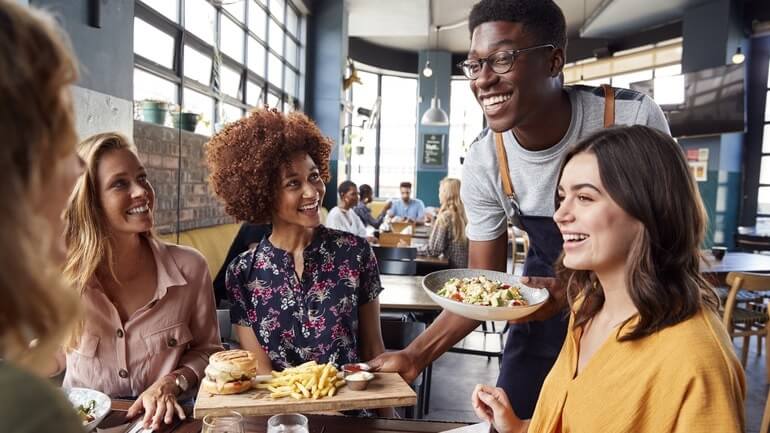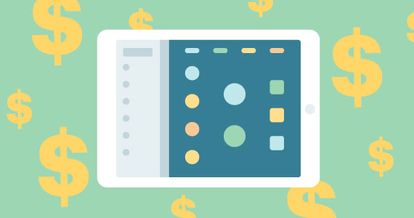A CRM for restaurants is key to getting to know your customers and personalizing service at scale. As a restaurateur, you’re not only in the business of food, but also in the business of hospitality. A customer relationship management system built for restaurants is your secret weapon for knowing what your guests want and creating dining experiences they’ll remember.
And when your restaurant CRM integrates with your other tech, like your restaurant POS system, you gain access to powerful information that can:
- Help inform business decisions
- Personalize service
- Improve your loyalty program
- Keep customers coming back for more
If you’re considering adding a CRM for restaurants to your tech stack, you’ll want to read this guide to get the scoop on this essential software. You’ll learn:
- What a CRM is
- What a restaurant CRM system is
- The benefits of using an integrated restaurant CRM system in your business
What Is a CRM?
CRM stands for “customer relationship management platform” and refers to software that serves as a database for customer information. Customer data collected in CRMs typically includes contact information, a history of the customer’s interactions with the business, and details about the customer’s preferences and behaviors.
Virtually any company that sells products and services, including restaurants, uses CRMs. And it’s typically the people in customer-facing roles that tend to engage with a company’s CRM databases more than employees in other roles.
Sales people, for example, use CRMs to take and save notes about sales pitches, calls, and meetings. They then use that data to personalize interactions with and offers to potential customers.
So, how do businesses use customer relationship management in the restaurant industry? Keep reading to find out.
What Is a Restaurant CRM System?
A restaurant customer relationship management system is software that restaurants use to gather data about their customers for the purpose of providing personalized service and sending targeted marketing offers.
Restaurants typically use CRMs to collect guest information, such as:
- Contact details: Typically collected when a customer joins a restaurant’s loyalty program or makes a reservation.
- Interaction history: A log of the customer’s orders, reservations, and interactions with promotions.
- Preferences: Including dietary preferences (vegan, vegetarian, etc.), allergens (soy, gluten, dairy, etc.), favorites (chocolate cake, scotch on the rocks, etc.), and table preferences (booth, high top, outdoor table, etc.).
- Notable dates: Birthdays, the date of their last visit, and the date they first joined your loyalty program can help you determine personalized offers.
Unlike CRMs that are not intended for the hospitality industry, CRMs for restaurants are specifically designed to integrate with the rest of the tools in your restaurant’s tech stack. This means that an integrated CRM for restaurants can share data with your POS, loyalty program, reservations system, and more.

9 Benefits of Using an Integrated Restaurant CRM
When your CRM works seamlessly with the rest of your restaurant’s tech stack, your tools can share data and help you unlock new, actionable insights.
Using an integrated CRM at your restaurant can help you by:
- Consolidating key customer data
- Keeping customer data secure
- Understanding customers – their behavior and ordering patterns
- Analyzing sales trends
- Facilitating target marketing efforts
- Improving your loyalty program
- Boosting sales
- Helping you provide personalized service
- Making restaurant upselling and cross-selling more effective
To provide a better understanding of some of the above advantages, here’s a deeper look at the benefits of using integrated customer relationship management in the restaurant industry.
1. An Integrated Restaurant CRM Consolidates Key Customer Data
An integrated CRM serves as a database that gathers key information about guest behavior and preferences in one place. While it lets restaurants add manual notes about guest preferences, a CRM’s true power lies in its ability to automatically collect data. This power saves your team from having to import that information or manually enter it during the checkout process.
For example, POS-CRM integration reveals data like a customer’s number of visits, their total spend, their average spend per visit, date of their last visit, and their online vs. on-premise order split.
Additionally, a loyalty program-CRM connection adds points earned and redeemed, interactions with marketing offers, and guest behavior (like average spend, visit frequency, and order history) to a customer’s profile.
Because an integrated CRM consolidates all your data into one platform under one profile per customer, you no longer have to open different tools to find all this valuable information about your customers.
2. A Restaurant Customer Relationship Management System Keeps Customer Data Secure
It can be bad news for business if your customer data falls into the wrong hands. Fortunately, an integrated CRM has several features that keep data secure.
First, when all of your customer information is stored on one platform, there’s less risk of it being compromised because it isn’t being shared by multiple systems that each run the risk of being hacked. And because your team members have unique logins, you can easily track who accesses guest data and when.
Second, integrated restaurant CRMs use state-of-the-art data encryption technology to ensure sensitive information can’t be intercepted by hackers. Simply put, encryption obscures the meaning of data so that it can only be read by those for whom it’s intended.
Finally, a hybrid cloud-and-local-network system like TouchBistro’s keeps data safe and accessible in case restaurants have an internet or power outage.
3. A Restaurant CRM Helps You Understand Customer Behavior and Ordering Patterns
Your restaurant CRM helps you get to know each and every customer on an individual level by pulling every interaction a customer has ever had with your restaurant into a single customer profile. This profile acts as a digital paper trail of crucial information like spending history, reservation times, and ordering patterns.
Instead of all of that information being siloed into your reservations platform and POS, an integrated restaurant CRM collects it all in one place, giving you a comprehensive understanding of each guest.
4. A CRM for Restaurants Aids in Analyzing Sales Trends
The data collected by your restaurant’s customer relationship management platform also reveals insights into customer behavior and ordering patterns on a macro level. When your CRM shares data with the rest of your tech stack, you unlock new reports that make it easy to identify and analyze sales trends that power business decisions.
For example, your CRM could reveal that a specific pairing of dishes – wonton soup, egg rolls, and Peking Duck – is very popular with takeout and delivery customers. You can then use this information to upsell your off-premise customers by creating a meal combo that includes those dishes and a dessert.
5. An Integrated CRM Facilitates Targeted Marketing Campaigns
Targeted marketing is more effective than mass marketing. When you know when your customers like to dine with you and what they like to order, you can send them targeted marketing messages with personalized offers.
Let’s say you run a cafe that serves both coffee and tea. Your guests tend to prefer one drink or the other. Through data in your integrated restaurant CRM, you see that your coffee drinkers frequent your cafe in the morning, while tea drinkers tend to come in the afternoon. You want to boost tea sales in the morning and coffee sales in the afternoon, so you create a special promotion for your loyalty program members.
Because your CRM has been collecting drink preferences, you can easily distinguish your coffee drinkers from your tea drinkers and send the right customer segment the right offer: discounted tea in the morning for your tea drinkers, and discounted afternoon coffee for your coffee drinkers.
When restaurants send the right promotion to the right person at the right time, customers will be more likely to accept it than if you send every customer the same, generic offer.

6. A Restaurant CRM Improves Your Loyalty Program
Some restaurants have loyalty programs, like TouchBistro Loyalty, that double as a CRM platform. Customers sign up for loyalty programs because they want to be rewarded for their repeat business. When they do this, they opt in to letting the restaurant track and store data about their behavior and interactions with the business.
You can then use that information to make your restaurant loyalty program more appealing and effective. Plus, if you have an integrated marketing solution like TouchBistro Marketing, you can further segment diner data and set up automated marketing campaigns.
When your loyalty program CRM and POS work together, you can better understand customer behavior than if you had a standalone loyalty program. The CRM-POS connection helps you see things like what offers customers are more likely to take you up on (BOGO or a percent discount?) and when to send out targeted promotions via email or your dedicated restaurant web app, thanks to powerful reporting capabilities.
7. An Integrated Customer Relationship Management System Boosts Sales
A two-in-one loyalty program and restaurant CRM helps boost sales by driving repeat business. Your loyalty program incentivizes customers to make a habit out of dining with your restaurant through targeted, timely promotions.
For example, when your sandwich shop offers loyalty program members half-priced sandwiches at lunchtime every Wednesday for a month, they’ll get used to having your sandwiches in the middle of the day and will end up coming in for lunch on other days of the week even after the promotion has ended, which ultimately helps increase revenue.
8. A Restaurant CRM Helps You Provide Personalized Service
For full service restaurants, an integrated CRM system helps your restaurant offer personalized service that creates a memorable experience for guests that keeps them coming back.
Let’s say a first-time customer makes a reservation at your restaurant, thereby opting in to your CRM. Upon arrival, the guest asks to be seated in a booth, so the host makes note of the guest’s seating preference in the CRM. After this first visit, the guest makes a reservation for another visit the following week.
Because this customer spent a lot during their first visit, you want to make sure their next visit is memorable so that they keep coming back. So, before the guest’s arrival, your front-of-house team checks out the guest’s CRM profile and sees that they prefer a booth and ordered several martinis last time.
So, the host assigns the guest to a booth and the server brings them a complimentary martini upon arrival. Your customer will think you’re able to read minds, and you’ll have a regular for life.
9. A CRM Makes Upselling and Cross-Selling More Effective
Beyond helping you turn first-time visitors into loyal regulars, an integrated restaurant CRM also facilitates cross-selling and upselling, helping you increase every check size.
As you know, targeted marketing is more effective than mass marketing. You can apply this principle to service by encouraging servers to reference customer profiles to provide diners with personalized, high-value recommendations they’ll be likely to accept.
If a guest frequently orders a glass of your house red wine, you can offer samples of similar, but pricier, red wines to influence them to go for the more expensive option. Or, if you can tell that a customer likes avocados based on their previous burrito orders, you can cross-sell them a combo that includes another avocado product, like guacamole and chips.
Integrated CRMs: A Restaurateur’s Secret Weapon
Think of a restaurant customer relationship management system as your business’ secret weapon for delighting guests and driving restaurant customer loyalty. When your CRM integrates with the rest of your restaurant’s tech stack, it can gather all kinds of data about your customers – from order frequency and timing, to dietary preferences and restrictions. You can then use this powerful information to personalize service, create targeted marketing campaigns, and generate more revenue.
Free Restaurant Cleaning Checklist
Sign up for our free weekly TouchBistro Newsletter







